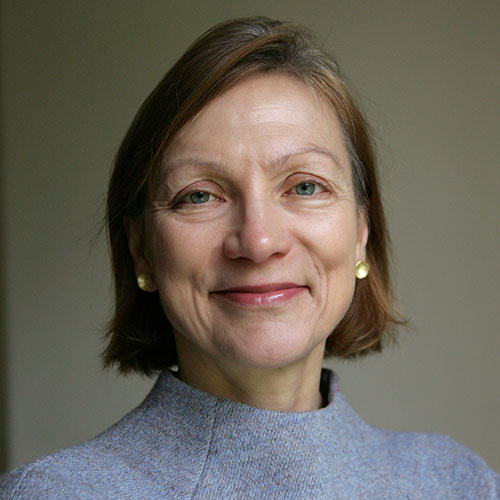In The Hot Seat / Loic Le Gaillard and Julien Lombrail
Art dealers, visionaries and founders of Carpenters Workshop Gallery.
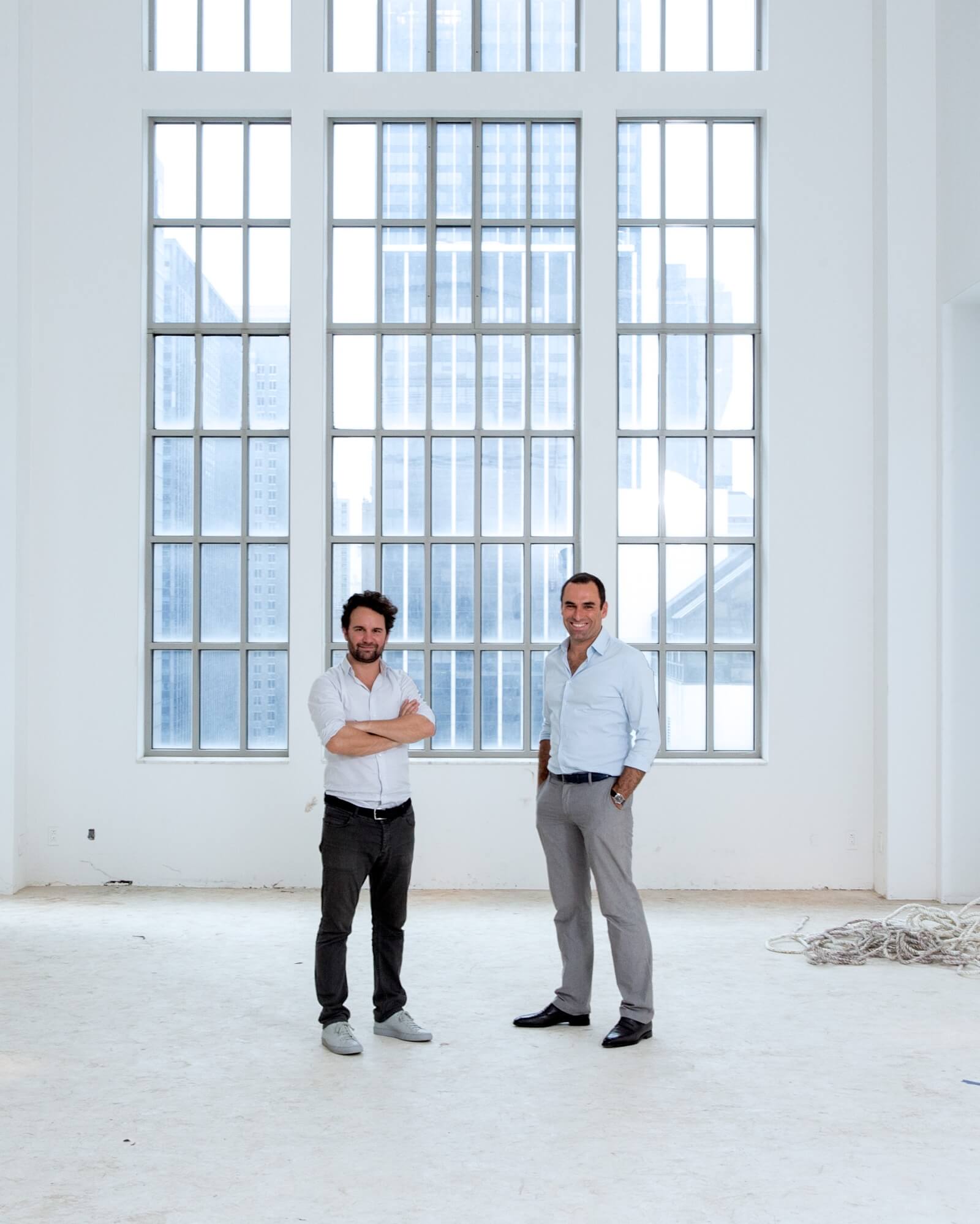
Loic le Gaillard and Julien Lombrail, Carpenters Workshop Gallery New York
COURTESY: Carpenters Workshop Gallery
How did you begin?
Loic: I guess I needed a job. You reach a certain point in your life, when you have this epiphany about what you really want to be doing. From that moment onwards there has been no turning back.
Julien: We were both in our separate cities, London and Paris, dreaming of having a contemporary gallery and representing artists, so that is what we tried to do on our own. We discovered that it is a very busy market and it can take a lot of time and money to get to the artists we wanted. However, we saw an opportunity to work together in sculptural design, where the market was only being developed by antiques dealers. We realised that these people were artists, and they were making sculpture, but nobody was representing them as a gallery.
What were you doing before?
Loic: I graduated in London with a degree in corporate finance and then for twelve years I had a business in the cosmetics industry. I put together designer brands, and sold them to large companies. I do not miss it!
Julien: As a student I’d been fired from two business schools, so I decide to create my own company. I did everything – I designed websites, and worked in the movie industry and in the sports industry. Then I helped my mother, Ingrid Donat, to start her business as a sculptor. She made some pieces of furniture and that was how I realised that there was real potential in design.
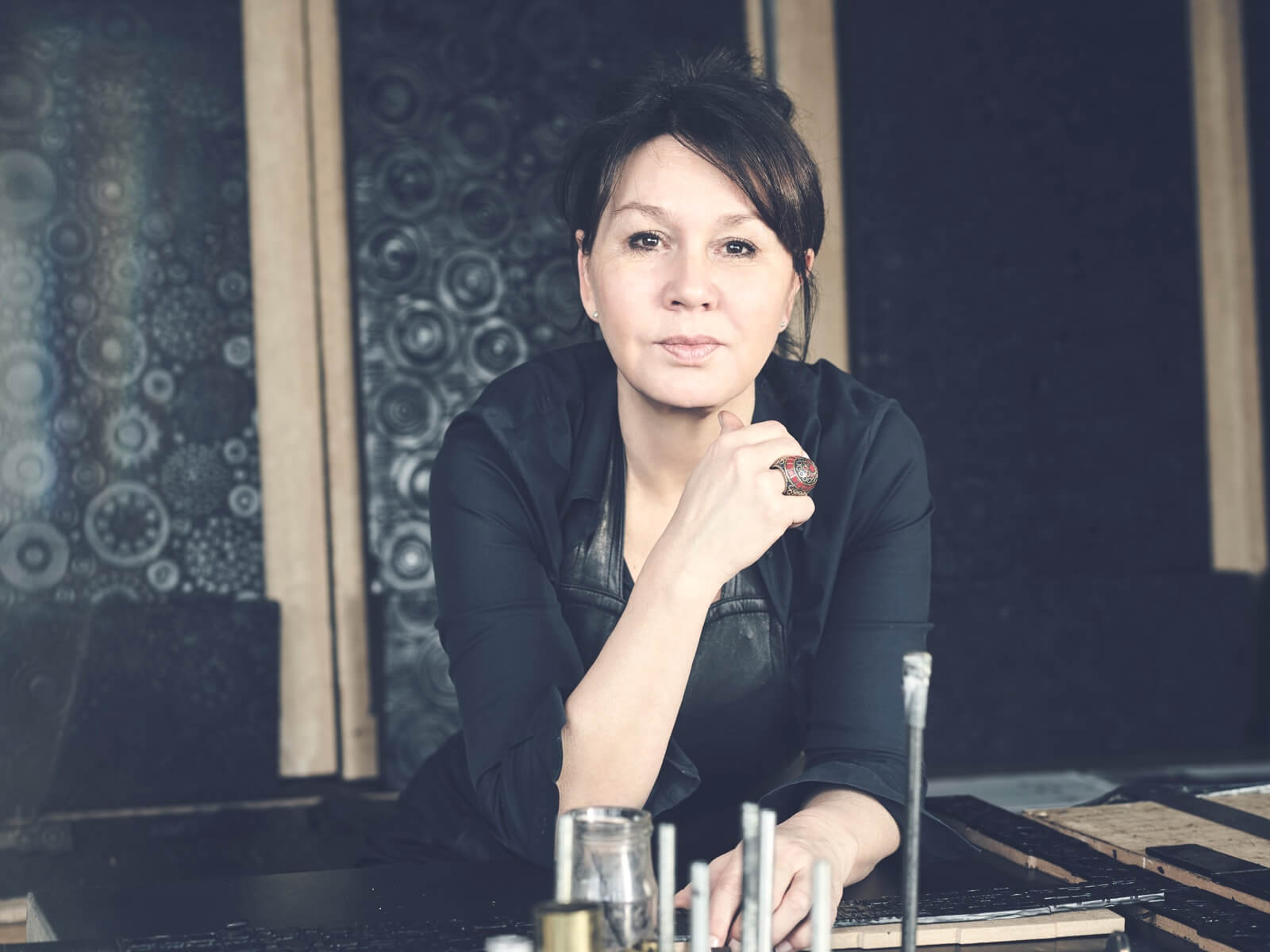
Ingrid Donat
COURTESY: Carpenters Workshop Gallery
Was there a critical moment?
Loic: It all started when Julien came over to London. He stayed in my place. I was in a 47 sq metres apartment, and Julien slept on the couch for six months. [Julien: A year and a half!]. We each had the equivalent of £30,000, so we set ourselves a budget for one year of £60,000.
What was the hardest part of starting out?
Julien: Access to artists. Some would not even give us a meeting. So that is why we went into art schools, like the Royal College of Art and the Eindhoven Academy, and found most of the artists we represent today – before they had even graduated.
Loic: In the early years we didn’t have a clear vision of who we wanted to be, and what Carpenters Workshop Gallery would become. We worked with some designers and sculptors, but also with vintage works, photography and painters. It was going in all sorts of directions. It took us two or three years to sharpen our focus.
Julien: We knew that we had to focus to make a difference. We wanted to make a difference. It was about finding something that would motivate us every year; something to fight for every day. We needed a cause.
What are the criteria you have evolved for a project you want to get behind?
Julien: Firstly, we both have to be excited – if one of us is hesitating, even slightly, we don’t go further. Secondly, we want to see something that is really new and genuine, with real creativity. And finally, we ask whether the project has longevity and a chance to pass into the history of art and design. When the answer is yes to all these questions, we are ready to go.
Loic: The artist himself is as important as his art. This industry is really tough, so we want to be sure that the artist is articulate, serious, hard working and honest. We need to know that we can invest in someone, and that we have a real, professional partner with us.
Julien: We have always adopted a long-term strategy. If it is not long term, we don’t put our energy into a project – we’re not interested in a quick fix.
Examples?
Loic: I guess one of the artists to whom we will always remain incredibly grateful is Joep Van Lieshout from Atelier Van Lieshout. When we met him he was already a big deal and had exhibited in many museums and art galleries, but he was still keen to get on board. He heard about our project and came up with a show called Bad Furniture.
Julien: It was a label that we loved – it was so us.
Loic: It was quite amazing. It was probably one of the very first design shows we did and it sold out. As a result we thought, “OK, being a gallery is incredibly easy, you just put stuff out and people buy it all.” It was the poisonous success of the early days.
Which have been your favourite moments?
Julien: We had to save money at every level. One day a gentleman showed up in our space, which was almost impossible to find, and we sold him one photograph. So we rented a truck and drove it round to his house, and instead of delivering one photograph, we delivered two photographs plus two huge pieces in bronze by Ron Arad. We said, “Oh this is your photograph, and by the way, we have some other pieces in this truck that could fit in your home … Would you like us to try them out in situ?” And he said, “Yes, sure.” We discovered his living room was on the first floor, so we had to stagger upstairs carrying these huge pieces. But the outcome was he bought everything.
Loic: Another time we sold a light box, and the client wanted to save a bit of money on the delivery, so we thought, maybe we could carry it by scooter. So we tried to manage the light box between ourselves, on our scooters. As I was driving ahead Julien shouted over to me, “Please drive slowly, because the wind is pushing me back, and if you go too fast I am going to fall off!”
Julien: It was so ridiculous. We were laughing and crying. We managed to deliver it in one piece!
Loic: Another great moment was when we did the Never-EverLand project with Joep Van Lieshout at Basel Art Fair, in 2009. An anonymous client contacted the booth, enquiring about the Mini Capsule Hotel, a kind of integrated sleeping capsule, with six rooms, and suddenly we found ourselves talking to Brad Pitt and surrounded by cameras and hubbub. After about twenty minutes Brad Pitt asked us, “What’s the ticket?” The piece is still in his home in California.
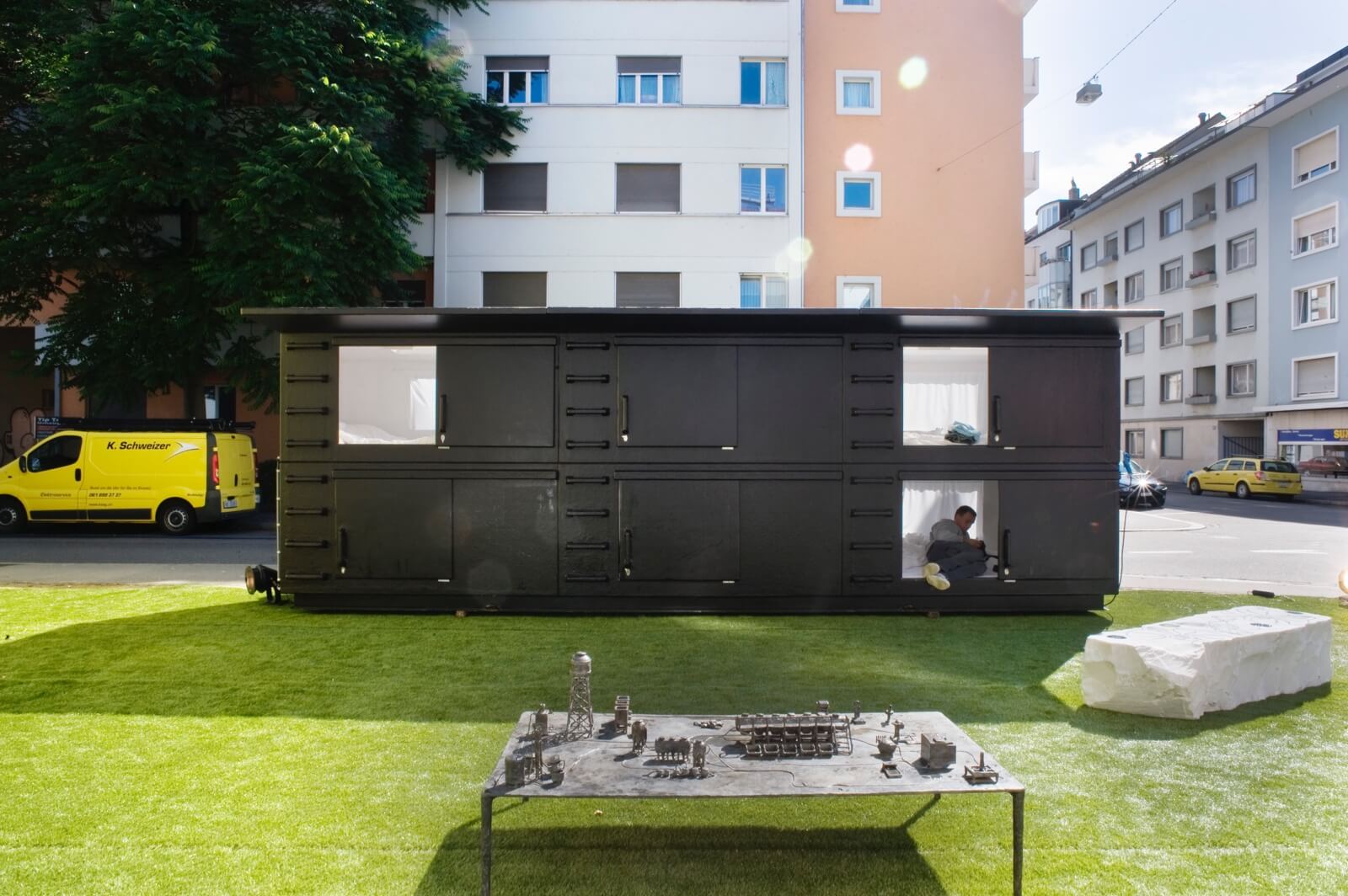
Atelier Van Lieshout, ‘The Mini Capsule Hotel’, 2009, at ‘Never-EverLand’, Design Miami/Basel 2009
COURTESY: James Harris
Julien: And the cost of bringing this mini hotel to Basel was more than everything we had, but we just did it because we thought it was artistically relevant.
Loic: What is quite amazing is that whenever a gamble has made sense artistically, it has always paid off.
What is the most exciting bit of the business?
Julien: For me it is our workshop. There is not one art or design gallery in the world that has integrated their own workshops for their artists. This tool is really something I am very passionate about.
Loic: There is a crisis for artisanship because most artisans are undercapitalised, and so they are not open to the new world, or to new techniques and equipment – they just do not know how to survive in the contemporary world. Our vision was to accommodate them all under one roof and to create an ecosystem, with a buzz and a sense of purpose. We wanted to give them the right equipment and a reason to carry on. On the back of this, we have teamed these great experts with some young apprentices, so not only do we have a tool which allows us to make our pieces – but it is sustainable.
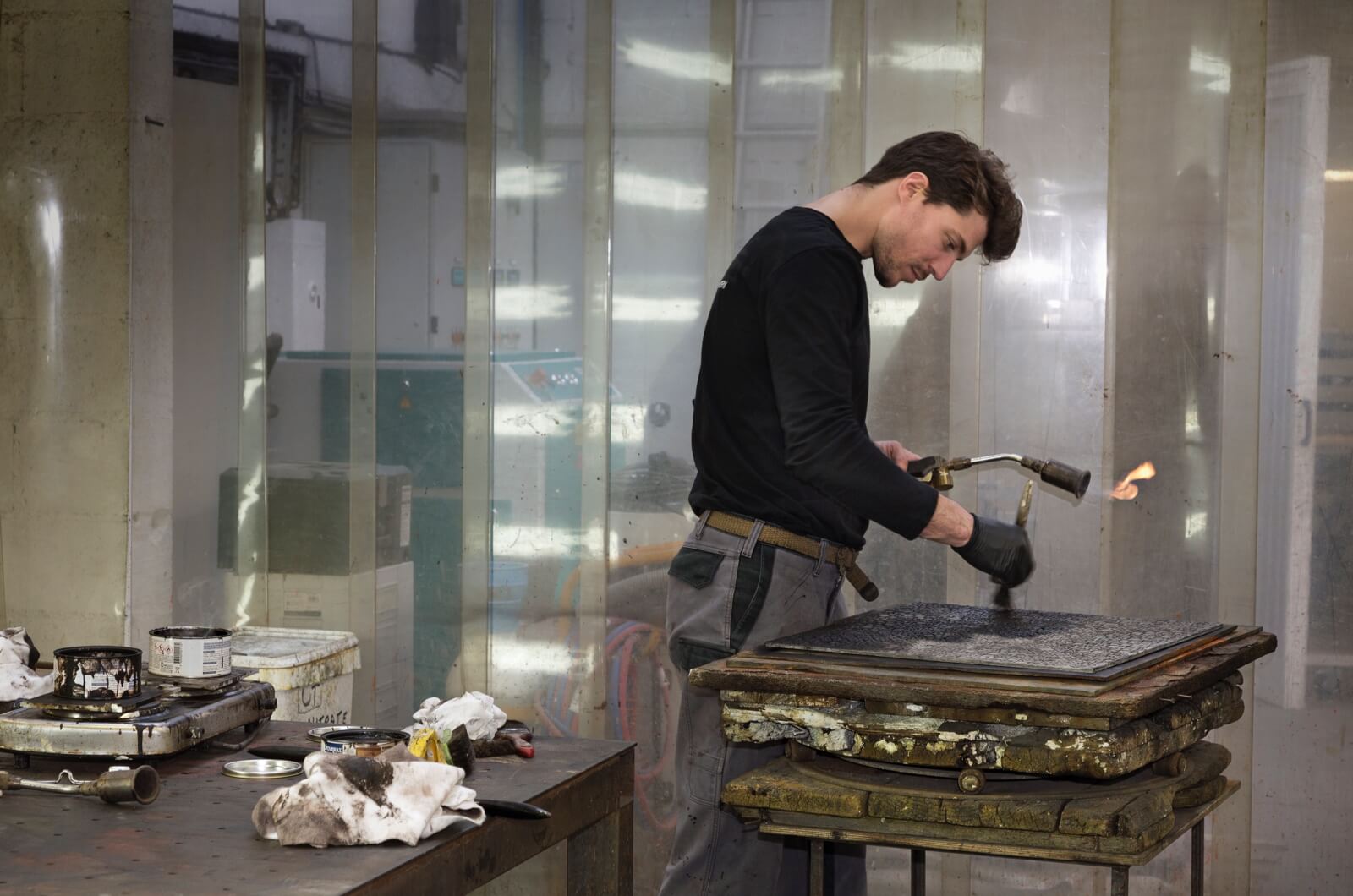
Carpenters Workshop/Mitry-Mory, Roissy, France
COURTESY: Carpenters Workshop Gallery
Which of your galleries do you think expresses you best?
Loic: I would think New York, simply because there is something stupidly big and flash and incredible about it. It’s a very ballsy building and I guess we are ballsy, but at the same time it is very human, and it feels good.
Julien: For me it is the workshops, which is the place where we exhibit some works. If necessary, we could operate only with this part – because it is the source of everything.
Great moments with artists?
Loic: One of my most emotional memories has been the time we spent with Wendell Castle, because there was always this sense of wisdom and humility in Wendell, which humbled you. Whenever we spent time with Wendell, he kept reminding us that he was this little boy from Kansas and that he had started from nothing. It was always something incredible for him to be in London or Paris, away from his childhood Kansas.
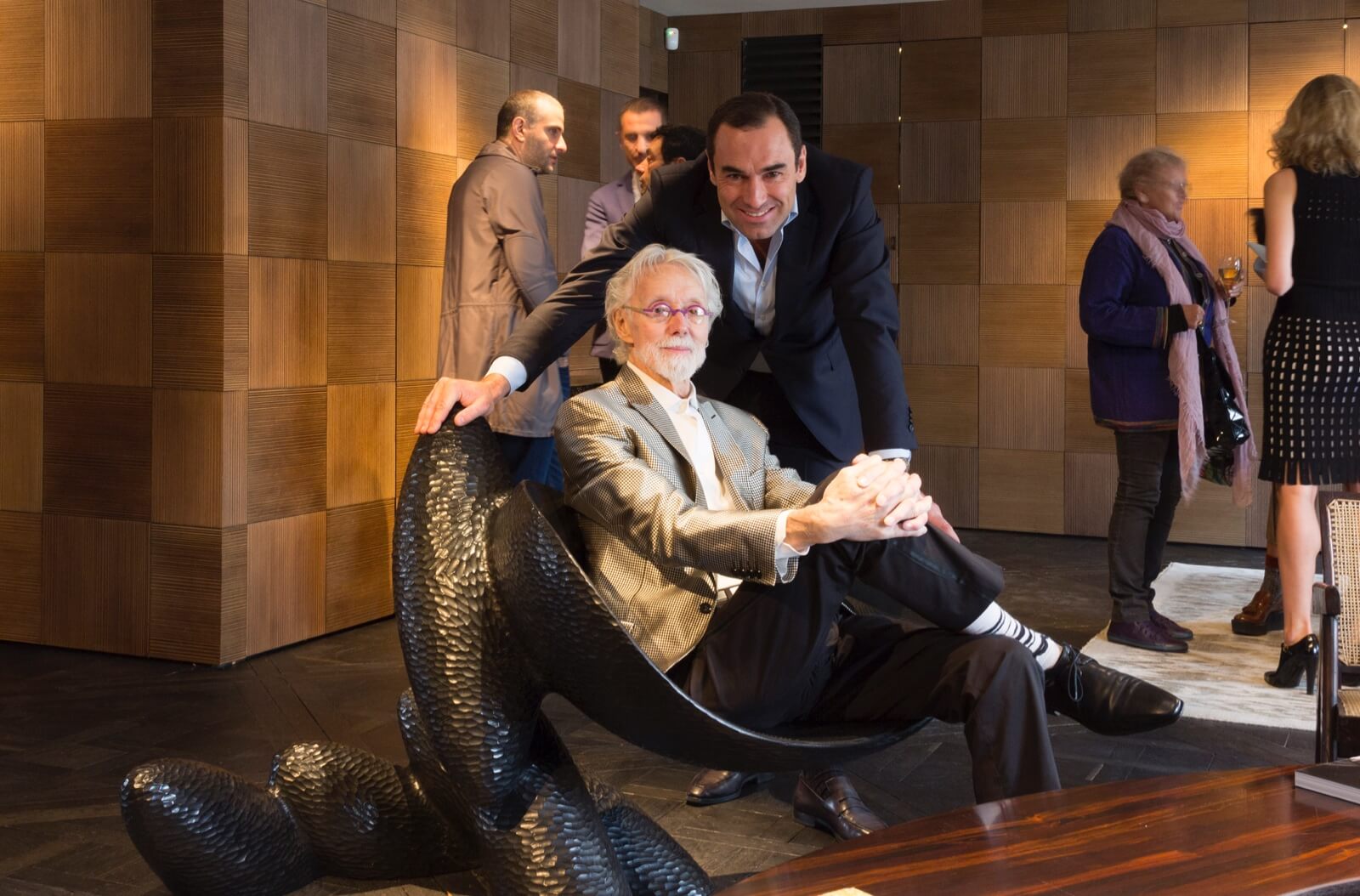
Wendell Castle and Loic le Gaillard
COURTESY: Carpenters Workshop Gallery
Julien: My mother [Ingrid Donat] and I have a very special working relationship. We started together when she was forty, and I was twenty. When I look back at what has happened over the last twenty years it is incredible: for her, for me, and for the gallery. This family thing is something very important to me – and to Loic as well I think. It is what drives us to create a group of talented people, a tribe. My mother symbolises all of this.
Loic: In many ways she is the godmother.
Julien: My mother has known Loic since he was a young boy, since the age of four, so it is a very unusual situation. This relationship with my mother helps us to understand other artists, because we know what an artist is afraid of, and what he or she needs.
Loic: And we know what it is to run a studio, because in a way we run Ingrid’s studio as well – we know both sides of the business.
Favourite piece from the last twelve years?
Loic: For me it is the ‘Technocrat Table’ [2007] by Joep Van Lieshout. It comes from a body of work that has lasted around twenty years, creating in miniature a kind of utopian city where art can be created. For me, this table is exactly what we stand for: there is the functionality of the table, but it is equally a sculpture. It blurs the boundaries between contemporary art and design. On top of that, it is beautiful bronze cast, so it has all the qualities that we would look for in an artwork.
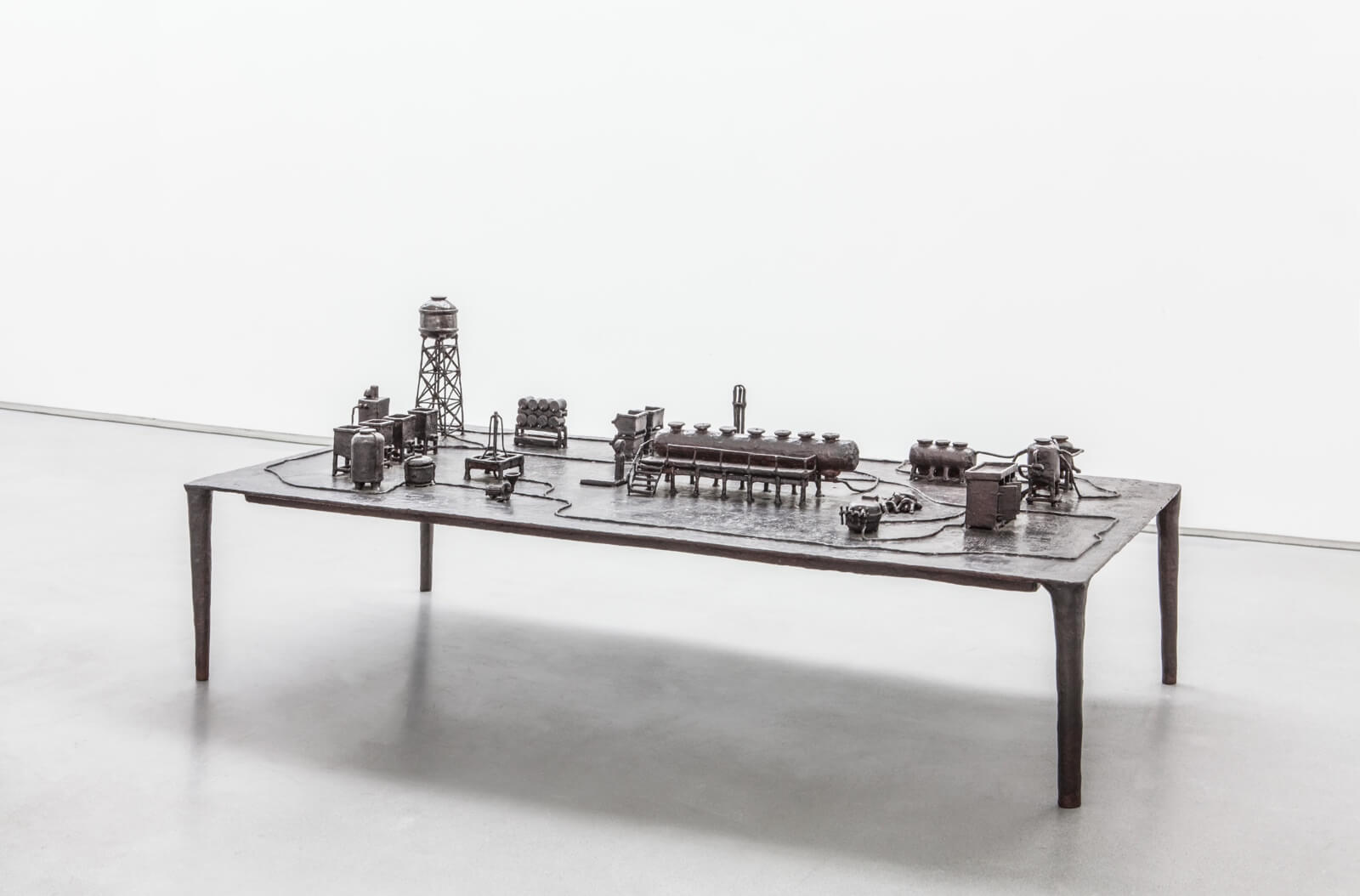
Atelier Van Lieshout, ‘Technocrat Bronze Coffee Table, 2007
COURTESY: Carpenters Workshop Gallery
Julien: I won’t talk about a favourite piece, but one piece I think was very relevant was the ‘Fragile Future III light installation’ [2008], which amazes everybody – and still amazes me after all these years. I have two in my home. And I remember when we met Ralph [Nauta] and Lonneke [Gordijn] of Studio Drift, they were exhibiting on the street with two dandelions, a wooden panel, and a wire connecting them both. We were struggling to find new artists at that time and I remember we said to each other, “We won’t sell a single one because it is too fragile obviously, but it is so poetic, so creative.” It has turned into one of the biggest hits of the gallery.
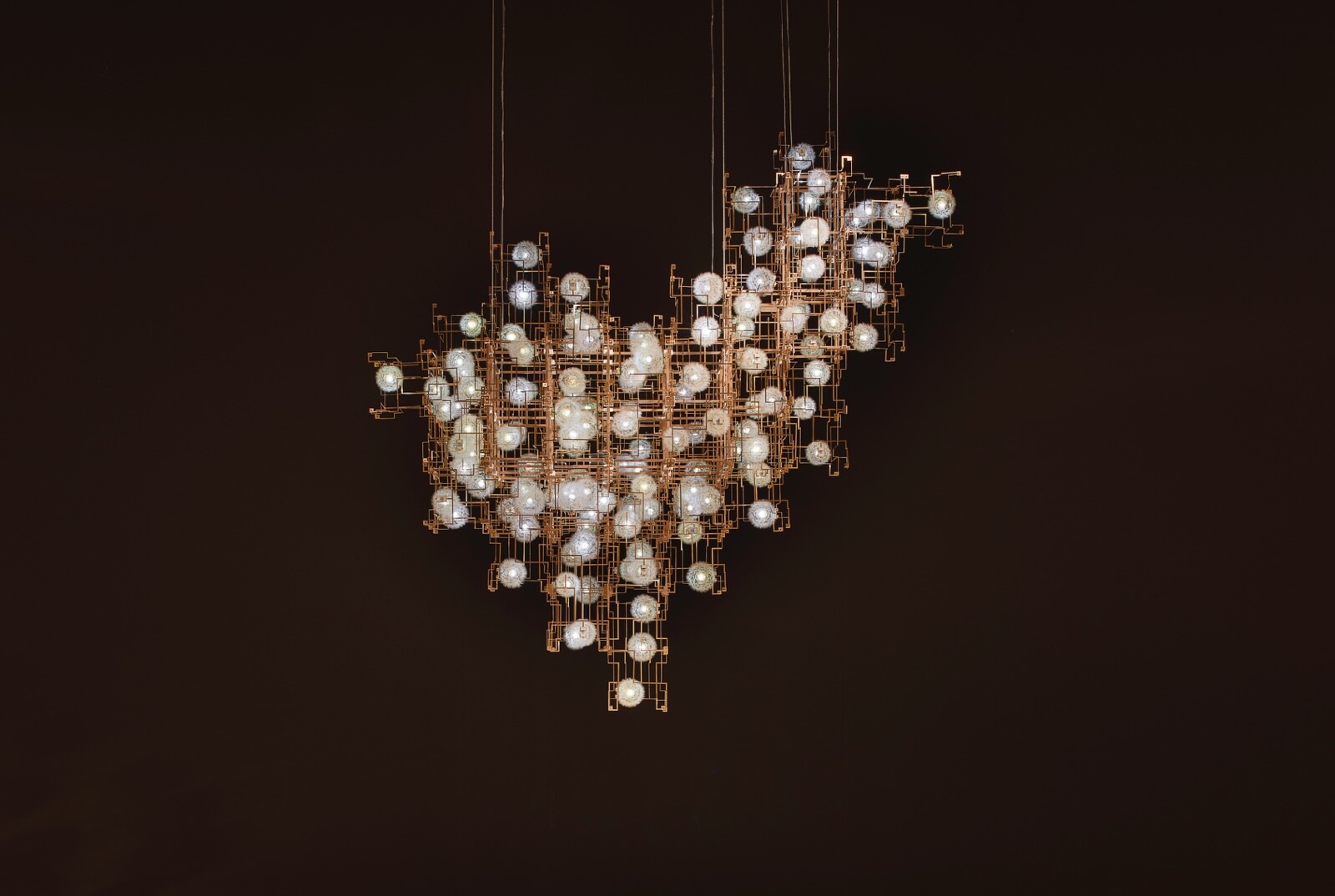
Studio Drift, ‘Fragile Future, Chandelier 3.11’, 2017
COURTESY: James Harris
Loic: This body of work was one of the first of our artists’ works to go into the permanent collection of the Victoria and Albert Museum. They are also one of the rare artists from our stable who have had an exhibition that young at the Stedelijk Museum Amsterdam.
What do you do best?
Loic: I think what we do best is being artistic directors. We go into artists’ studios and look at what they have, then we make some vague adjustments or comments about a piece, and make it an even better piece. We push them and give them the confidence to go further in one area or another. We resurrected the concept of the clocks with Maarten Baas, which has been an immense success. With Fragile Future we suggested moving from wall-mounted pieces to chandeliers.
Julien: I think we are very good at getting people excited. Starting with artists, but also collectors and up through to the Italian Government with the Venice project. We know how to share the excitement we feel.
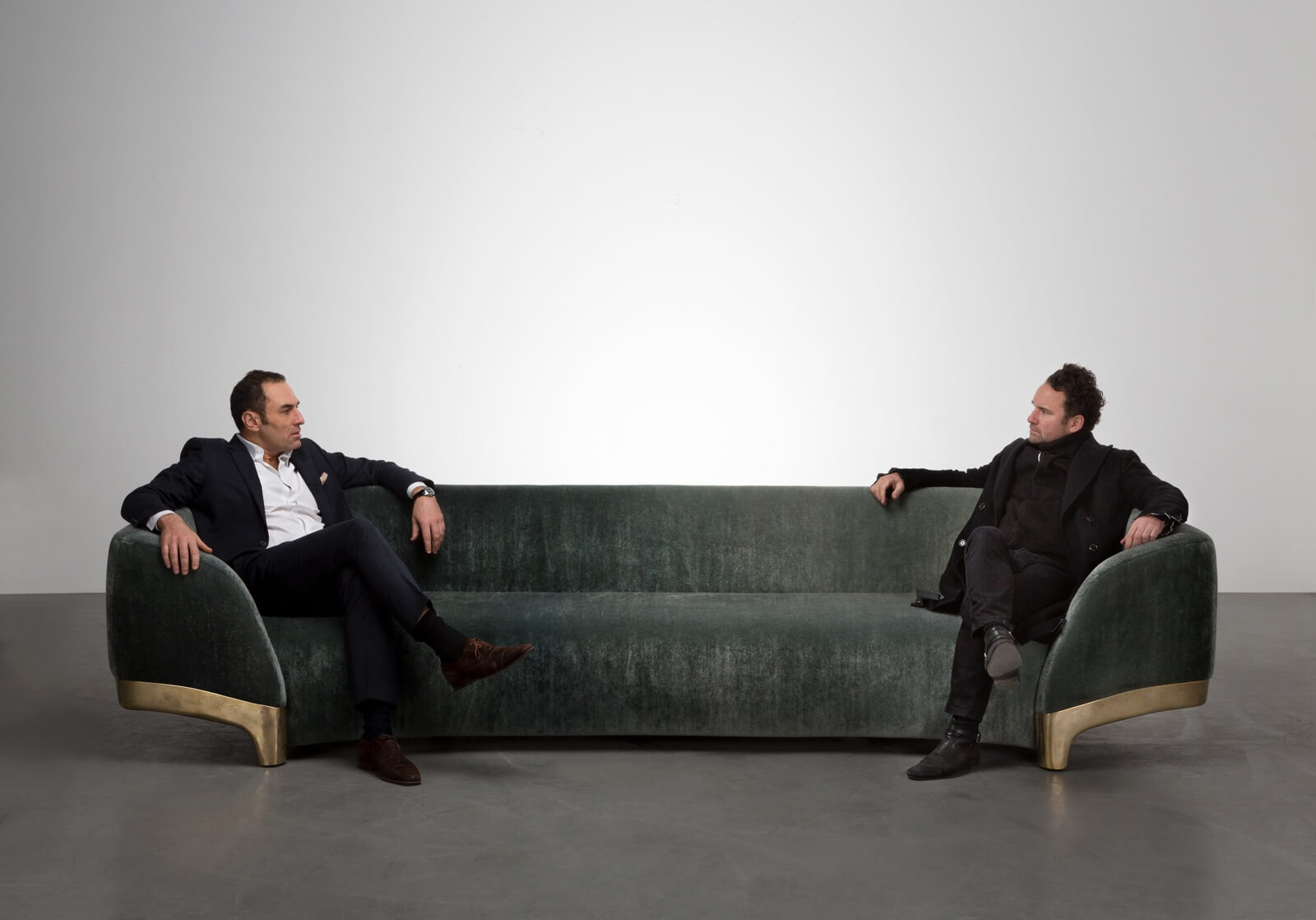
Loic le Gaillard and Julien Lombrail
COURTESY: Carpenters Workshop Gallery
Which bit of the job do you like best?
Loic: I am a compulsive buyer and I love buying. I love going to the studio, and quite often Julien stops me and says, “Let’s wait, let’s wait.” Because when I see something good I am frenetic and I want to buy it all. But I love the chase of finding the right thing in the studio and spotting something that turns me on … at that moment I am already putting in place a strategy to conquer the world with it.
Julien: For me, it is producing. When an artist comes with an idea, I like to push his mental boundaries and find the most exciting and interesting aspect – and then make it happen. That is what makes me high.
Carpenters Workshop Gallery – innovative art and design galleries in London, Paris, New York and San Francisco.
